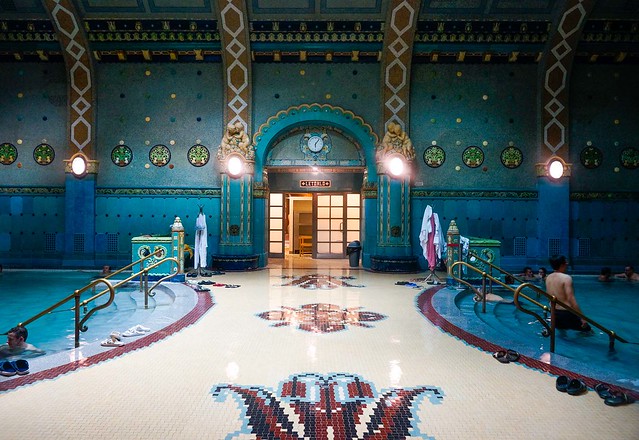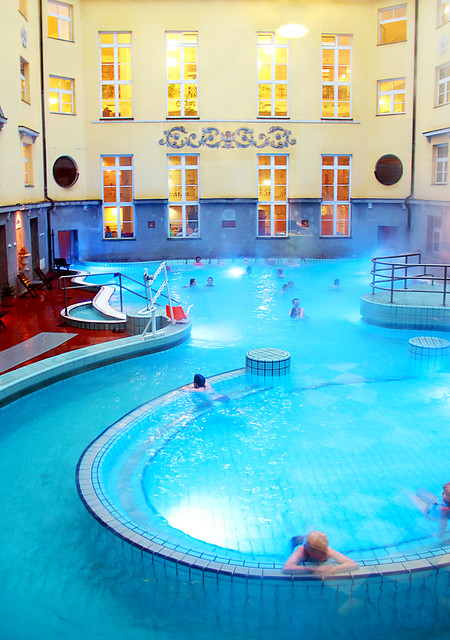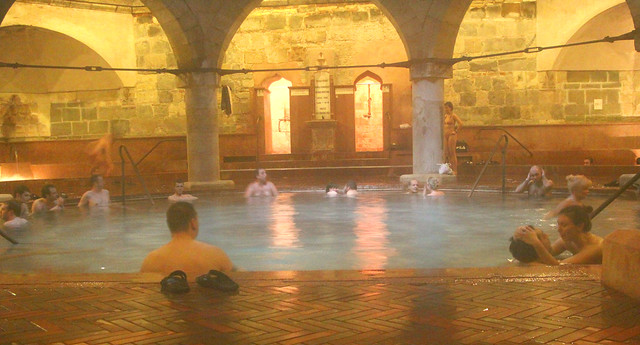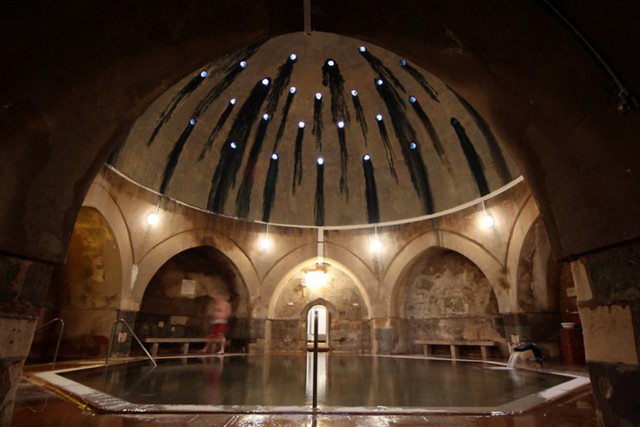History of Budapest’s Thermal Baths
A visit to one of Budapest’s thermal baths is one of the must do activities in Budapest. They are world famous and absolutely worth visiting. The history of Budapest has forever been linked with it’s thermal baths. One of the reasons the Romans first colonised the area is so that they could use the thermal springs for their baths. There are still ruins visible today in Óbuda of the enormous Roman baths that were built during that period.
A lot of baths were built in Budapest during the Turkish period in Hungary and they served both bathing and medicinal purposes. Some of these Turkish baths are still in use to this day including most of the 5 large bath complexes listed here.
Which bath should I go to?
It really depends on what kind of experience you are after.
If you just want to go to the biggest and most famous of Budapest’s thermal baths, then I suggest a visit to Széchenyi Baths. It’s one of the most expensive, but also the most impressive structure.
The most beautiful bath is in my opinion, Gellért Bath. The very impressive Art Deco interior would be worth visiting for its historical art style alone! Gellért is the most beautiful, but also the most expensive.
Finally, if you want to save money, you should try one of the smaller baths. Not only are they cheaper but they also attract few tourists. I personally really like Lukacs Bath. It is smaller complex, authentic and not crowded while still being a decent size. Rudas Bath is a similar size and also cheap tickets for the morning session. The cheapest option is Kiraly Bath. It also the smallest with fewer thermal pools than the others.
What should I bring?
You should bring the same things you would bring to a trip to the beach. This means a towel, swimsuit and clothes to change into when you leave. If you plan on spending a lot of time in the outside pools in summer, I suggest bringing sunscreen. But please be very careful not to pollute the indoor pools with it. Wash your skin thoroughly in the showers available before entering a thermal pool.
You are required to wear slippers or flip flops when walking around the complex. So bring them with you if you do not want to buy them onsite.
Swimming caps are required for all persons in the swimming pools (lap pools). If you have one, bring it, otherwise you can buy one on site. A nice souvenir! Caps are not required in the thermal pools.
It is possible to rent towels and also to purchase a swimsuit inside the bath. There are cafeterias inside the baths that sell food and beverages. They accept cash and card. It would be possible to bring a small snack with you from outside if you want.
Will I need to be naked in front of other people?
All of the baths I have been to require swimsuits in all of the thermal baths. Some of the baths do have Finnish saunas that require you to be naked when inside, but there are regular saunas as well where swim suits are required.
In most of the baths there are separate cabin/locker areas for men and women. In Lukacs bath, the locker areas are unisex, but changing booths are provided instead for private changing. In the baths that do not have changing rooms, you may be required to change in the presence of the others, but men and women are in separate areas.
Gellért Baths does include a naturist sundeck, but ticketing is separate and the area not visible from the rest of the complex.
What to do once inside the bath. Step-by-Step.
Firstly you need to pick your ticket type. Most of Budapest’s thermal baths include access to either a cabin or locker with your ticket. You must pick one. Unless you are particularly shy, just pick a locker. The cabins allow for some privacy while changing, but nothing else. Detailed ticketing options for each bath can be found on the official websites for each bath.
After purchasing your ticket, head to either the locker or cabin areas to get into your swimsuit. Any kind of normal swimsuit is acceptable. A bikini or one piece is normal for woman and swimming shorts or briefs for men. After buying your ticket you are giving a wrist watch that is used to lock your cabin or locker and gain entry to the baths.
Next, head to your bath of choice! The bathing pools tend to range in temperature from around 26ºC right up to 42ºC. There are also steam rooms, saunas and cold plunge pools to use. My favourite thing to do is to alternate between the hot baths, steam room and cold plunge pool. I really recommend trying out all the different baths and exploring all the options.
Make sure you shower and wash your skin before entering the pools. There are showers located all around the complex. You should also wash off any chlorine before entering an indoor pool if you have been in the outdoor pools. I really enjoy the outdoor pools, but they are less relaxing than the indoor pools.
I like to get my moneys worth at the baths so will often soak for a few hours, then grab some food from the cafeteria and relax in a deck chair for a while before heading back to the pools for another hour or so.
The Bath Houses
Szechenyi Bath
The Széchenyi Baths are one of the largest bathing complexes in all Europe, and the only one of Budapest’s thermal baths to be found on the Pest side of the city. There is an atmosphere of grandeur about the whole place with the bright, largest pools resembling aspects associated with Roman baths, the smaller bath tubs reminding one of the bathing culture of the Greeks. The three outdoor pools are open all year round. The biggest and most popular bath in Budapest. Expect to see a lot of tourists.
Széchenyi Baths is located a short way from the centre of the city and has a subway station on the M1 line located adjacent to the baths. However you can also get there by taking a walk down the lovely Andrassy Avenue from the city centre.
A daily ticket with cabin usage is 4900 HUF. There are limited options for discount tickets at Széchenyi. You can save a small amount purchasing a morning or afternoon ticket, but the discount is small.
Gellért Baths
The Gellért Baths and Hotel were built in 1918, although there had once been Turkish baths on the site. In 1927 the Baths were extended to include a wave pool, and the effervescent bath was added in 1934. The well-preserved Art Nouveau interior includes colourful mosaics, marble columns, stained glass windows and statues. The most beautiful of Budapest’s thermal baths in my opinion.
The standard adult ticket on weekdays with locker is 5300 HUF. There are no options for discounted entry meaning Gellért is the most expensive thermal bath in Budapest.
Gellért Baths is located just south of Gellért Hill and can be easily accessed by walking across the Liberty Bridge from the city centre. It can also be accessed by using the M4 metro line and getting out at Szent Gellért tér station. Trams also regularly run across the Liberty bridge. Tram numbers 47 and 49 run from Deák Ferenc tér to Gellért baths very regularly.
Lukács Thermal Bath
The Lukács Baths are also in Buda and are also Turkish in origin, although they were only revived at the end of the 19th century. This was also when the spa and treatment centre were founded. Since the 1950s it has been regarded as a centre for intellectuals and artists. It is my favourite of all Budapest’s thermal baths, mainly due to the relaxed atmosphere, minimal tourists and cheaper entry fee.
A daily ticket with locker is 3300 HUF. Cheaper tickets can be purchased if entering after 5pm or if staying less than 2 hours making it a good choice for travellers on a budget.
Getting to Lukács Baths is very easy. The number 4 and 6 trams run in a semi-circle shape around the Pest side of the city and then across the Margaret Bridge. As soon as the tram has crossed Margaret Bridge, exit and then walk the rest of the way. It is only a few hundred metres.
Rudas Bath
The Rudas Baths are located in the narrow strip of land between Gellért Hill and the River Danube and are an outstanding example of architecture dating from the Turkish period. The central feature is an octagonal pool over which light shines from a 10 m diameter cupola, supported by eight pillars.
An adult thermal ticket with a cabin on weekdays 3 300 HUF. There are good discounts available for morning sessions. So if you want to visit a thermal bath but are on a budget, head to Rudas around 9am. Added bonus is that you will nearly have the place to yourself.
The easiest way to get to Rudas Baths, is walk across the Elizabeth Bridge (white suspension bridge). It is a very pleasant walk.
Kiraly Bath
Király Bath was first built in the second half of the sixteenth century, during the time of Ottoman rule. It still retains many of the key elements of a Turkish bath, exemplified by its Turkish dome and octagonal pool. The Király Bath includes a thermal pool, massage treatments, a sauna and steam room, and a Finnish sauna for two people with a cold pool.
A daily ticket with a locker only cost 2 400 HUF. There are also good discounts available for students or for morning only tickets. These options make Kiraly Bath my recommended choice for the budget conscious, particularly students.
Getting to Kiraly Baths is quite simple. The number 4 and 6 trams run in a semi-circle shape around the Pest side of the city and then across the Margaret Bridge. Kiraly Baths is located a few hundred metres south of the western side of the Margaret Bridge. Catch the tram across, exit, and walk the rest of the way.
How do I get to the baths?
Budapest’s public transport network is fully integrated into google map. This means you find public transport options to get from your accommodation to any of the baths very quickly. I have labelled the five main baths on the map below to give you an idea on where they are located.








Leave a reply